![]()
Monday, September 23, 2013
The Al-Nusra Front (Jabhat al-Nusra) is an Al-Qaeda Salafist-jihadi network, prominent in the rebel organizations in Syria. It seeks to overthrow the Assad regime and establish an Islamic Caliphate in Greater Syria, a center for regional and international terrorism and subversion. This study, conducted by the Meir Amit Intelligence and Terrorism Information Center, focuses on the Al-Nusra Front, the most significant organization among the jihadist organizations operating in Syria. The study is structured in seven sections[*], which if read in conjunction with each other, draws a complete picture of the Al-Nusra Front.
Section One
General description of the civil war in Syria
The Al-Nusra Front was founded during the uprising in Syria, which broke out in mid-March 2011 in the Daraa Governorate, a tribal rural area in the country’s south. Since then, the uprising has spread to all parts of Syria to become a civil war. The Assad regime (supported by Iran, Hezbollah, and Russia) and a heterogeneous rebel coalition (supported by the U.S. and the West, Turkey, Saudi Arabia, Qatar, and Jordan) are pitched against each other in a war of attrition that is raging across the country. The Syrian civil war can be viewed in the wider context of the intense upheaval that is currently gripping the Arab world, in which the rulers of Tunisia, Egypt, Libya, and Yemen have been removed from power so far.
Now, more than two years after the uprising first broke out, Syria can be said to be a country in a process of disintegration, even though Bashar Assad’s regime has shown a marked ability to survive (and in recent months has even had some success in fighting against the rebels). As far as governance is concerned, Syria should not be considered a country intact, seeing as the Assad regime currently has no control over extensive portions of Syria. It mostly controls two regions of what it considers high-priority territory: the Damascus-Homs-Aleppo area (which the Syrian regime is trying to cleanse of rebel forces), and the Tartus-Latakia area in western Syria, the stronghold of the Alawite sect. The Assad regime is working to establish its control in these areas and is fighting “the state of the rebels”, who control about two thirds of Syria’s inhabited territory.[4]
Caught between the warring sides, the Syrian population is plagued by growinganarchy, economic and social crisis, and governmental vacuum, all of which are exploited by the Al-Nusra Front and the other global jihad organizations to entrench themselves on the ground. According to various estimates, the fighting in Syria has claimed over 100,000 lives so far. According to a report issued by the U.N. human rights office on June 3, 2013, at least 92,901 people were killed by late April 2013, a number which has since increased. The report said that November 2012 saw the beginning of a dramatic increase in the number of people killed in the rural areas of Damascus and Aleppo, where the regime is working to establish its control (www.un.org). According to the Syrian Center for Human Rights, there have been 106,423 documented fatalities since the start of the uprising, about half of them civilians (Al-Sharq al-Awsat, August 11, 2013). In addition, U.N. data suggest that 1,773,586 people fled from Syria. They found refuge in Jordan (487,000), Turkey (413,000), Iraq (161,000), Lebanon (608,000), and other Arab countries (data.unhcr.org, as at mid-July 2013).
The rebel groups, numbering approximately 100,000 fighters, are divided and split along ideological, religious/ethnic, and regional/local lines. Some of those groups subscribe to Syrian nationalist ideology, others are Islamist in character (running the gamut from what is considered moderate to radical Islam), others still are based on tribal or clan affiliations, and finally, there are those whose identity is Salafistjihadi (of which the Al-Nusra Front is particularly prominent). Due to their considerable division, which compromises both the effectiveness of the fighting and the rebels’ ability to obtain Arab and Western assistance, the rebels found it necessary to unite their ranks and establish umbrella networks to lead the rebellion. Under the auspices of Arab and Western countries, the Syrian National Coalition (SNC, led by Ahmad al-Jarba) and the Free Syrian Army (FSA, led by General Salim Idris) were founded. However, the functioning of those bodies is lacking, and they have limited influence on the rebel groups and on the situation on the ground. In addition, internal conflicts occasionally take place between them, at times deteriorating into violent clashes in which the Al-Nusra Front takes part as well.
As of the summer of 2013, most of the fighting takes place in the suburbs and rural areas of Damascus, as well as in the cities of Homs and Aleppo and their surrounding countryside. Fighting also takes place in southern Syria (the Daraa region) and the Golan Heights (from where it has spilled over into Israeli territory on a number of occasions, albeit not by the Al-Nusra Front). Along with other rebel groups, the Al-Nusra Front is actively involved in the fighting in several hotspots, particularly the Damascus region and the Aleppo and Homs regions. Even though the Syrian regime has made a number of achievements in recent months, it seems that its war of attrition against the rebels is far from being decided.
Entrenchment of Al-Qaeda operatives in Syria before the establishment of the Al-Nusra Front
According to a report by the British Quilliam think tank, the foundation for the establishment of a jihadist network in Syria was laid as early as in 2000. In that year, Abu Musab al-Zarqawi, who would go on to become the founder of Al-Qaeda’s branch in Iraq, dispatched a number of operatives who had worked with him in Afghanistan to Syria and Lebanon. Those operatives established “guesthouses” in Syria to train and funnel operatives to Iraq. In the course of the fighting against the United States and its allies in Iraq, Syria was a transit station for Arab and Muslim jihadist operatives making their way to the Iraqi theater of operations.
In March 2011, when the uprising began, Al-Qaeda’s branch in Iraq (the Islamic State of Iraq, ISI) decided to send Syrian and Iraqi jihad operatives skilled in guerilla warfare into the country. Early on, therefore, the Al-Nusra Front was inseparably linked to Al-Qaeda in Iraq. However, it later defined itself (also by name) as an autonomous organization and strengthened its direct links with Al-Qaeda under Al-Zawahiri, until formally becoming an Al-Qaeda branch.
According to the Quilliam report, top Al-Nusra Front operatives held a number of meetings between October 2011 and January 2012 in the Damascus countryside and Homs. At these meetings, a decision was made to establish a jihadist organization to join the ranks of the rebels. The organization’s objective would be to create an Islamist state in Syria and establish a caliphate in Greater Syria (Bilad al-Sham). It was also decided to build military capacity for the organization, seizing opportunities to collect weapons and train new recruits, and reinforce the Syrian consciousness of the Islamist nature of the fighting against the Assad regime.
Declaration of the founding of the Al-Nusra Front (January 24, 2012)
On January 24, about one year after the uprising broke out, the Al-Nusra Front released a video in which its leader Muhammad al-Julani announced the organization’s establishment and declared jihad against the Syrian regime (similarly to subsequent videos released by the Al-Nusra Front, Al-Julani’s statement was delivered off-screen). He said that toppling the Bashar Assad regime would only be half of the battle, since the ultimate objective was to implement Islamic religious law (Shari’a) and unite under the banner of Islam. He said that it was a crime for the rebels to accept the aid of Western countries to topple the Syrian regime — a crime which Allah will not forgive. He went on to say that the West and the U.S. were partners in the crimes committed by the Syrian Ba’ath regime. Al-Julani referred to the Turkish government as a pawn in the hands of the U.S. administration, despite calling itself Islamic. He voiced his opposition to the initiative proposed by the Arab League to resolve the Syrian crisis and strongly condemned the Iranians, saying that they were seeking to “revive the time of the Persian empire”. The video was accompanied by footage of Al-Nusra Front operatives in various battle zones in Syria (Damascus, Hama, Mayadeen, Idlib, Abu Kamal, Daraa, Deir ez-Zor).
Images from the YouTube video announcing the founding of the Al-Nusra Front
The split of the Al-Qaeda branches in Syria and Iraq
The Iraq and Syria branches of Al-Qaeda are divided, working as competing and sometimes even hostile organizations in the Syrian civil war. The Al-Nusra Front was established in Syria by Al-Qaeda’s Iraqi branch, which directed it early on. The Syrian amir, Abu Muhammad al-Julani, apparently took his orders from the Al-Qaeda amir in Iraq, Abu Bakr al-Baghdadi, who was to all intents and purposes the commander of the Al-Qaeda branches in Iraq and Syria. Apparently, to give some formality to his control over the Al-Qaeda branch in Syria, on April 9, 2013 Al- Baghdadi released an audiotape announcing the unification of the organizations in Iraq and Syria into the Islamic State in Iraq and Greater Syria (Al-Sham) (youtube.com).
However, just one day after Al-Baghdadi’s announcement (April 10, 2013), Abu Muhammad al-Julani, the amir of Al-Qaeda’s branch in Syria, swore allegiance to Ayman al-Zawahiri, the leader of Al-Qaeda. Ayman al-Zawahiri, who was forced to take a stand in view of the power struggles between the two branches, announced on June 10, 2013 that the union between the Al-Nusra Front and Al-Qaeda’s branch in Iraq was no more. In a letter he sent to Al-Nusra Front operatives in Syria, Al-Zawahiri said that Abu Bakr al-Baghdadi was wrong when he declared the union “without our approval, without having consulted with us, and without informing us.” Accordingly, Al-Zawahiri called on the two branches to cooperate with each other “and stop any verbal or physical attack against the other side” (annahar, June 10, 2013, citing a letter obtained by Al-Jazeera TV from “reliable sources” in Syria).
In the letter sent to the Al-Nusra Front, Al-Zawahiri recognized the organization as an Al-Qaeda branch in Syria that was not subordinate to the Iraqi branch, and thus in fact made his decision on the dispute between the two. However, instead of settling the dispute, his decision only further escalated the differences of opinion between supporters of Al-Julani and those of Al-Baghdadi, causing them to split and weakening them both (at least temporarily). Those differences also posed a challenge to Al-Zawahiri, seeing as the leadership of the Al-Qaeda branch in Iraq, under Abu Bakr al-Baghdadi, publicly refused to obey Al-Zawahiri’s command. Abu Bakr al-Baghdadi rejected Al-Zawahiri’s ruling, questioned its authenticity, and insisted that the Islamic State in Iraq and Greater Syria should continue to exist as an autonomous political entity reflecting the joint efforts of jihad in Iraq and Syria.[5]
Another challenge to Ayman al-Zawahiri could be seen in a statement made by Abu Muhammad al-Adnani al-Shami, the official spokesman of the Islamic State in Iraq. In the statement, posted on YouTube on June 19, 2013, Al-Adnani expressed his discontent with Al-Zawahiri’s decision to rescind the union between the two Al-Qaeda branches and said that the Al-Qaeda branch in Iraq was determined to continue operating in Syria alongside the Al-Nusra Front. Al-Shami went on to say that the split that formed between jihad warriors in Syria as a result of Al-Zawahiri’s remarks harmed the unity and camaraderie of the jihad warriors, since some of them went back to Iraq, some remained in their homes to avoid a civil war, and some joined other rebel groups. For the time being, it appears that the initial shock has been overcome and both Al-Qaeda branches are entrenching themselves as independent organizations in the Syrian theater of operations.
Abu Muhammad al-Adnani then gave an ideological explanation for the refusal of the Iraqi Al-Qaeda branch to follow Al-Zawahiri’s instructions. He said that Islam does not recognize the artificial borders laid down in the Sykes-Picot Agreement (1916). Accordingly, dividing the Islamic State in Iraq and Greater Syria “contradicts our view and our faith.” Al-Adnani concluded by saying, “No one will prevent us from helping our brothers in Syria, fighting the Nusayris [i.e., Alawites], and waging jihad; no one will prevent us from remaining in Syria. The lands of Syria and Iraq will remain one scene, one front with no boundaries to separate them” (YouTube, June 19, 2013).
The emergence of the Islamic State in Iraq and Greater Syria as a competitor for the Al-Nusra Front
In the wake of these developments, Al-Qaeda’s infrastructure in Syria split into two competing organizations:
- The Al-Nusra Front, headed by Abu Muhammad al-Julani, the more prominent and dominant organization of the two. It is formally recognized by Ayman al-Zawahiri as the Al-Qaeda branch in Syria.
- The Islamic State in Iraq and Greater Syria (Al-Sham), under the command of Abu Bakr al-Baghdadi, which operates as the Syrian branch of the Iraqi Al-Qaeda. That organization, which has embraced stricter methods of operation, has become a competitor for the Al-Nusra Front, with power struggles waged between them.
In the second half of August 2013 it was reported that Abu Muhammad al-Adnani, the spokesman of the Islamic State in Iraq and Greater Syria, was appointed by Abu Bakr al-Baghdadi as the organization’s leader in Syria. According to Iranian and Arab media reports, Abu Muhammad al-Adnani is a Syrian from Idlib who holds radical views and is well trusted by Abu Bakr al-Baghdadi (Iran’s Al-Alam TV, August 17, 2013).[6] The main base of support of the Islamic State in Iraq and Greater Syria is in northern Syria, mainly the Aleppo and Al-Raqqa governorates (Policy Watch, September 10, 2013).

Abu Muhammad al-Adnani, the spokesman of the Islamic State in Iraq and Greater Syria, who was appointed as the organization’s leader (Iran’s Al-Alam TV, August 17, 2013).
The process of Al-Qaeda’s infrastructure in Syria splitting into two competing organizations was also accompanied by the formation of separate military-operative systems for each organization. The Islamic State in Iraq and Greater Syria soon started carrying out its own independent military operations. The first operation for which the Islamic State in Iraq and Greater Syria claimed responsibility was an attack on a border crossing between Syria and Iraq on March 4, 2013 and the killing of 48 Syrian soldiers and nine Iraqi guards (Aaron Y. Zelin, “Al-Qaeda in Iraq Enters the Syrian Conflict”, Al-Wasat, March 11, 2013).
The Islamic State in Iraq and Greater Syria subsequently expanded its operations into other areas in northern Syria. For instance, a video released on June 17, 2013 on behalf of the Islamic State in Iraq and Greater Syria showed footage of a suicide bombing attack in Aleppo, with a car bomb going off at a Syrian military compound (youtube.com). Another report was released on June 17, stating that the Islamic State in Iraq and Greater Syria fired mortar shells at Syrian tanks in the vicinity of Aleppo (halabnews.com). Prior to that, on May 15, 2013, a video was posted showing the execution of three Syrian army soldiers in the city of Al-Raqqa in northern Syria by the organization’s operatives (youtube.com). On June 10, 2013 it was reported on YouTube that three operatives of the Islamic State in Iraq and Greater Syria executed a child who was selling water in the city of Aleppo for disrespecting Prophet Muhammad.
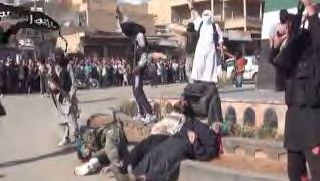
A child executed in downtown Al-Raqqa. The video posted on YouTube shows the Al-Qaeda flag and the caption “The Islamic State of Iraq and Greater Syria (youtube.com).
The Al-Nusra Front, on its part, renounced the killing of innocent civilians and attempted to distance itself from the violent tactics used by the Islamic State in Iraq and Greater Syria. This could be seen in an interview given by Abu Idris, a top Al-Nusra Front operative, who was introduced as the amir of Hama, to the All 4 Syria website. In the interview Idris denied media reports according to which the Al-Nusra Front was killing innocent civilians, arguing that they were part of an American media campaign intended to besmirch the organization. Abu Idris laid the blame on the Islamic State in Iraq and Greater Syria and the foreign operatives working for it. He also argued that the offensive attitude of the Islamic State towards civilians was one of the reasons that the organizations had split (eaworldview.com, citing an interview given to All 4 Syria on July 18, 2013).
The split between the two Al-Qaeda branches working in Syria is also evident in the sphere of public relations. The Al-Nusra Front has a media network called the White Minaret for Production of Information Materials (see Section Seven). The Islamic State in Iraq and Greater Syria also created its own public relations wing: the Baqiya Institution for Media Productions (Mu’assassat Baqiya lil-Intaj al-I’lami).[7] It posted its first video online on July 12, 2013. The information wing of the Islamic State tries to gain the sympathy and support of the local inhabitants allegedly as a lesson from mistakes made in the Iraqi campaign. The following are two images from that first video (courtesy of MEMRI):
An expression of the sentiments felt by Al-Nusra Front operatives in the wake of the split between the two Al-Qaeda Branches could be heard in an interview given by one of the organization’s top operatives in eastern Syria to a reporter for The Guardian on July 10, 2013. According to that operative, at first there was a great deal of anger among foreign volunteers: Iraqis, Tunisians, Egyptians, and others. They were angry about the fact that the Al-Nusra Front would not take orders from the amir in Iraq. As a result, 80 percent of them joined the forces of Abu Bakr al-Baghdadi. It was a severe blow to the Al-Nusra Front, whose operatives had a hard time accepting a “civil war” between the jihadist organizations. That state of affairs changed, however, and the tables turned, as described by the top Al-Nusra Front operative:
“Yes, in the beginning they [al-Qaida in Iraq] did give us weapons and send us their leadership […] May Allah bless them. But now, we have become a state. We control massive areas, and they are but a faction. They don’t control land in Iraq: they were defeated. We have been sending them weapons and cars to strengthen their spear against the Iraqi rejectionist government, but now they want us to be part of them. That, I don’t understand”.
Collaboration between the Al-Nusra Front and the Islamic rebel organizations
Overview
The Al-Nusra front is not formally part of the coalition fighting against the Syrian regime. The reason is that the organization has qualms about extensive, institutionalized cooperation with rebel groups that do not share its radical Islamic, Salafist-jihadi ideology. On the other hand, the rebel groups are loathe to cooperate with the Al-Nusra Front, both because of the substantial differences in ideology and because of concerns about undermining their relations with Western countries and pro-Western Arab/Muslim countries that assist them.
As a consequence, the Al-Nusra Front prefers cooperating with Islamic military frameworks, even those that are not necessarily sympathetic to Al-Qaeda and its Salafist-jihadi ideology. Several leaders of Islamic military frameworks belonging to the rebel forces have repeatedly stressed that they are not affiliated with Al-Qaeda and do not support the establishment of an Islamic caliphate in Greater Syria. However, they have also said time and again that this does not prevent them from cooperating with the Al-Nusra Front. Three prominent frameworks with which the Al-Nusra Front cooperates are the Harakat Ahrar al-Sham al-Islamiyya (Islamic Movement of the Free Men of Greater Syria, hereinafter: Ahrar al-Sham), Kataeb al-Farouq (Al-Farouq Battalions), and Liwa al-Tawhid (Brigade of the Uniqueness and Unity of God).
Prominent Islamic organizations that collaborate with the Al-Nusra Front
Ahrar al-Sham is an important military organization with Salafist-jihadi characteristics. It was founded in early 2013 and consists of many thousands of operatives (up to approx. 10,000). It is headed by Abu Abdullah al-Hamawi (Hassan Aboud). Even though the movement seeks to establish an Islamic state in Greater Syria (similarly to the Al-Nusra Front), it is not affiliated with Al-Qaeda. Its main strength is in the Idlib and Aleppo governorates in northern Syria; however, it is also present in other governorates.
Hassan Aboud, the leader of Ahrar al-Sham, discussed his organization’s cooperation with the Al-Nusra Front in an interview given to Al-Jazeera TV on June 8, 2013):
- Ahrar al-Sham was born from a merger of four Islamic groups, which was announced on January 31, 2013. According to Hassan Aboud, Ahrar al-Sham is active in Aleppo, Idlib, and other governorates in Syria, with the exception of Al-Suwayda in the south and Tartus in the west. Ahrar al-Sham cooperates with other organizations in attacks on Syrian army bases and facilities and in providing social and healthcare services to Syrian citizens.
- Ahrar al-Sham is a movement of Islamic character that strives to establish an Islamic state in Syria and abolish the borders between Syria and other countries that were laid out in the Sykes-Picot Agreement. The movement is part of an umbrella network known as Al-Jabha al-Islamiyya al-Suriyya (Syrian Islamic Front), headed by Hassan Aboud. The umbrella network consists of 11 fighting military organizations, eight of which have merged with Ahrar al-Sham.
- Ahrar al-Sham collaborates with the Al-Nusra Front because, according to Hassan Aboud, “it is an organization characterized by strength, perseverance, and courage.” However, when asked whether Ahrar al-Sham is affiliated with Al-Qaeda, Hassan Aboud replied that his organization is not a branch of any other organization, group, or party (i.e., contrary to the Al-Nusra Front, the Al-Qaeda branch).
Another Islamic organization, which has its roots in the Free Syrian Army and cooperates with the Al-Nusra Front, is the Al-Farouq Battalions. Led by Osama Juneidi, the organization’s main strength is in the Homs Governorate; however, it has considerable presence along the Syrian-Turkish border and in other governorates. According to the organization’s spokesman, it consists of approximately 14,000 operatives (The Independent, U.K., June 17, 2013).

The insignia of the Al-Farouq Battalions. The text on the bottom reads “Jabhat Tahrir Suriya al-Islamiyya” (Islamic Front for the Liberation of Syria), an Islamic umbrella network consisting of various Islamic organizations (Al-Farouq Battalions, Liwa al-Tawhid, Suqour al-Sham, Kataeb al-Ansar, and Liwa al-Islam).
On June 17, 2013, an interview with Osama Juneidi, the commander of the Al-Farouq Battalions, was posted on YouTube. In the interview Juneidi said that his organization cooperates with the Free Syrian Army and other Islamic organizations, including the Al-Nusra Front, which has taken part in many battles alongside the Al-Farouq Battalions. Juneidi noted, however, that he is opposed to the establishment of an Islamic caliphate in Syria, saying that those who strive for that objective (i.e., the Al-Nusra Front) have no understanding of Syrian reality. He added that his organization’s priority is to establish an Islamic state based on the principles of Islamic religious law (Shari’ah), but noted that he will accept the choice of the Syrian people on whether or not they want to establish an Islamic state.
Liwa al-Tawhid (Brigade of the Uniqueness and Unity of God) is another Islamic organization with which the Al-Nusra Front cooperates. It seeks to establish an Islamic regime in Syria but is not affiliated with Al-Qaeda. It is headed by Abdul Aziz Salameh. According to the organization’s spokesman, it has approximately 11,000 operatives (a figure which we believe to be exaggerated). Its main source of strength is the Sunni population in the Aleppo region (The Independent, U.K., June 17, 2013).
Liwa al-Tawhid has military cooperation with Islamic rebel groups, including the Al-Nusra Front. For instance, in a video posted on YouTube on July 27, 2012, six operatives claimed responsibility for hitting a tank, an operation carried out jointly by the Al-Nusra Front and Liwa al-Tawhid. Another video (posted on August 13, 2012) showed an armed fighter waving the Al-Nusra Front flag while celebrating with Liwa al-Tawhid fighters and local civilians. On September 7, 2012 the Ahrar al-Sham movement released a video showing Al-Nusra Front and Liwa al-Tawhid operatives in a joint attack against a military installation in Aleppo.
Founding joint military frameworks of the Al-Nusra Front and other Islamic organizations
The cooperation between the Al-Nusra Front and Islamic organizations (some of them Salafist-jihadi and some of a moderate Islamic nature) has been reflected in founding joint ad-hoc military frameworks in Syria’s various governorates:
- On May 12, 2013 it was announced that Salafist-jihadi organizations were founding a joint military force to fight in the rural area to the east of Damascus (Eastern Ghouta). The joint force included the Al-Nusra Front and other jihadist organizations: Kataeb Ahrar al-Sham (Battalions of the Free Men of Greater Syria), Liwa al-Islam (Brigade of Islam), Liwa Suyuf al-Haqq (Brigade of the Swords of Truth), and other jihadist groups. The name given to the joint force was Al-Furqan Campaign (Al-Furqan being a term used to refer to the Quran).

A jihadist spokesman reads the announcement on the founding of the Salafi-jihadist army in the rural area to the east of Damascus, with the Al-Nusra Front flag raised in the background (youtube.com)
- On November 28, 2012 it was announced that a number of jihadist organizations established a coalition (the dominant organization being the Al-Nusra Front) in the Deir ez-Zor Governorate, eastern Syria. The coalition’s objective was to unite all jihadist frameworks in the region fighting for turning Syria into an entity governed by Islamic religious law (Shari’ah). The most prominent organization in the coalition was the Al-Nusra Front. Other member organizations included Kataeb al-Ansar (Battalions of the Assistants), Kataeb al-Abbas (Abbas Battalions), Liwa La Ilaha Ila Allah (No God But Allah Brigade), Katibat al-Hamza (Hamza Battalion), Katibat al-Sa’eqa (Assault Battalion), Katibat Jund al-Aziz (Al-Aziz Army Battalion), Katibat Izz al-Din al-Qassam (Izz al-Din al-Qassam Battalion), and Katibat Jabhat al-Da’wah wal-Jihad (Battalion of the Front for Islamic Preaching and Jihad (source: almhajralaslamy.blogspot.com).
- On November 20, 2012 fourteen Salafist-jihadi organizations fighting in the Aleppo region released a joint statement calling for the establishment of an Islamic state governed by Islamic religious law (Shari’ah). The organizations included the Al-Nusra Front (which appeared first on the list, perhaps an indication of its major role), Kataeb Ahrar al-Sham, Liwa al-Tawhid, Ahrar Suriya, and Kataeb al-Islam (longwarjournal.org).
The relationship between the Al-Nusra Front and the Islamic State in Iraq and Greater Syria
The Al-Nusra Front and the Islamic State in Iraq and Greater Syria (hereinafter: the Islamic State) are affiliated with Al-Qaeda, both sharing a similar Salafist-jihadi ideology and striving to establish an Islamic caliphate in Greater Syria. Despite that fact, and even though the Al-Nusra Front was founded by operatives from the Al-Qaeda branch in Iraq, the relationship between the two branches is hostile and has even turned violent on some occasions.[8] The cause for such hostility and violence is the personal rivalry between the leaders of the two organizations, power struggles, and perhaps also differences of opinion as to the course of action to be pursued in the “liberated territories”. In early July 2013 violent incidents took place between operatives from the two organizations. Apparently, at this point it is still a local phenomenon, one that the two organizations are interested in containing and preventing from spreading further.
One example of the differences of opinion between the two organizations could be seen in an article published in the Lebanese daily As-Safir (July 31, 2013), citing on the ground sources in rebel-controlled areas. According to the article, the Al-Nusra Front operates on the principle (shared by the Free Syrian Army) that the first order of business is to topple the regime, and only then should the Islamic state be founded. On the other hand, the Islamic State in Iraq and Greater Syria seeks to establish an Islamic caliphate while fighting to topple the Syrian regime.
The two organizations have the bulk of their military strength in northern and eastern Syria. In some areas in northern Syria, the Al-Nusra Front and the Islamic State operate as two separate entities. For instance, the two organizations conduct separate military activities in the city of Aleppo, where the Islamic State cooperates with rebel organizations that belong to the Free Syrian Army and with other military frameworks. In the civilian sphere, the Islamic State is not part of the Islamic religious law committees established in Aleppo by the Al-Nusra Front and rebel organizations that cooperate with it. Likewise, the two organizations work separately in the city of Deir ez-Zor, where they do occasionally cooperate in ad-hoc operations.[9] In the city of Daraa the Al-Nusra Front has retained its own identity. In the city of Al-Raqqa, on the other hand, the difference between the two organizations has become blurred (Syria Comment, July 13, 2013).
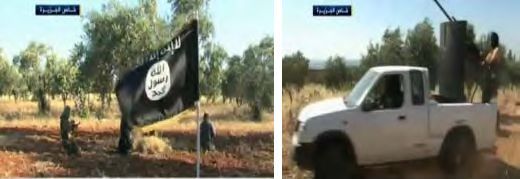
Islamic State operatives; the photograph was apparently taken near Aleppo (Al-Jazeera, July 2, 2013)

Islamic State operatives; the photograph was apparently taken near Aleppo (Al-Jazeera, July 2, 2013)
The Al-Nusra Front and the Islamic State in Iraq and Greater Syria’s connections with the Free Syrian Army
There are fundamental differences of opinion between the Al-Nusra Front and the Free Syrian Army (a military framework that represents most of the rebel groups). Both sides agree that their immediate objective is to topple the Syrian regime. However, while the Al-Nusra Front (and its partners) seek to establish a radical Islamic jihadist caliphate in Greater Syria, the stated objective of the Syrian National Coalition is “to establish a pluralistic democratic regime that would meet the demands of the Syrians” (Al-Sharq al-Awsat, July 7, 2013). These two distinct objectives reflect different fundamental views about the shape that Syria and the Syrian regime will take the morning after.
Given this state of affairs, the Al-Nusra Front’s connections with the Free Syrian Army are complex and problematic: on the one hand, seeing as they share a common immediate objective, they maintain ad-hoc cooperation at various hotspots of fighting, based on the principle that “the enemy of my enemy is my friend”. On the other hand, both sides realize full well that their fundamental contrasts will come to the surface in the longer run. The Free Syrian Army is also aware of the fundamental hostility of the international community towards the Al-Qaeda branch in Syria, and the misgivings harbored by Western countries about supplying weapons to the rebels due to concerns that the weapons could find their way into the hands of jihadist organizations that will turn Syria into a hub of regional and global terrorism.
Despite their ad-hoc cooperation, power struggles have emerged between the Al-Nusra Front (and the Islamic State) and the Free Syrian Army (and other rebel organizations). In early July 2013 those differences of opinion escalated into violent clashes, which have not become a full-scale confrontation so far. One recent example is the violent clashes that took place between the organizations in the Idlib Governorate:
- On July 6, 2013 the Syrian damaspost website reported that there were tensions between the Free Syrian Army and the Al-Nusra Front. The tensions first appeared in the Al-Adana region of the Idlib Governorate, sparked by an incident where girls were raped by several Al-Nusra Front operatives. This, according to the website, provoked violent clashes between the Al-Nusra Front and the Free Syrian Army, which announced that its operatives in all areas went on high alert.
- On July 6, 2013 the Zaman al-Wasl website posted a report, based on sources in the town of Al-Adana, on a violent confrontation between Free Syrian Army groups and Islamic State groups. The confrontation, the sources said, lasted more than five hours, during which over 15 people were killed and dozens were injured. The alleged reason for the confrontation was an attempt by Islamic State operatives to impose their authority on the residents of Al-Adana. The Al-Farouq Battalions, an Islamic military framework operating in northern Syria, intervened to put an end to the fighting.
Another incident of note, which took place in mid-July 2013, is the killing of a top Free Syrian Army officer, Kamal Hamami. The Free Syrian Army blamed the murder on the Islamic State, argued that the officer was murdered near one of the organization’s roadblocks in Jabal al-Turkman, in the rural environs of Latakia, and demanded that the murderers be turned in (Al-Jumhuriya, Al-Sharq al-Awsat, July 14, 2013). However, Free Syrian Army Spokesman Qasem Saadeddin expressed his concern that the murder would drag both sides into a civil war in which no one was interested (Al-Sharq al-Awsat, July 13, 2013). According to Arab media, on July 13 there were violent incidents between Free Syrian Army operatives and jihadist operatives in the rural areas of Idlib and in the Homs Governorate, but those incidents ultimately did not escalate into an all-out military confrontation.[10]
At any rate, it appears that, as far as rhetoric is concerned, the statements made by the Free Syrian Army against the Al-Nusra Front and other organizations affiliated with the global jihad became more vehement in the summer of 2013. Evidence to that effect could be seen in the remarks of Free Syrian Army Spokesman Fahd al-Masri. In his statement, he demanded that the foreign fighters belonging to Al-Qaeda, the Al-Nusra Front, and similar organizations leave Syria. He stressed that the Free Syrian Army would not let them remain in Syria, and would allow no extremist or terrorist to impose their agenda on the future of Syria (AKI news agency, Italy, August 3, 2013).
The confrontation between the Al-Nusra Front and the Islamic State in Iraq and Greater Syria on the one hand and the Kurds on the other
The Kurds, who are Sunni Muslims, currently make up the largest ethnic minority in Syria. Their number is estimated at nearly 10 percent of the country’s entire population. Most of them live in northern and eastern Syria, particularly in the governorates of Al-Hasakah, Aleppo, and Al-Raqqa. They took advantage of the governmental vacuum that was formed after the collapse of the Syrian regime in extensive areas across northern and eastern Syria to strengthen themselves from the military point of view, while encouraging a process of “Kurdization” in Kurdish population centers. In this context, they created their own military force, thousands of whose members had trained in Iraq’s autonomous Kurdish region and in training bases along the Syrian-Turkish border (Al-Nashra, Lebanon, July 24, 2013; Al-Sharq al-Awsat, August 4, 2013).
The rebel organizations, including the Al-Nusra Front and the Islamic State in Iraq and Greater Syria, have been equal parts respectful and suspicious of the Kurds. While the Kurds have claimed to support the revolt against Bashar Assad’s regime, they have been accused by the rebel organizations of harboring separatist tendencies and being willing to make their own political deals with the Syrian regime. Concerns about the Kurds’ separatist intentions and their connections with the Syrian regime are shared not only by the Al-Nusra Front and the jihadist organizations, but also by the Free Syrian Army and the Syrian National Coalition.
That fundamentally suspicious attitude turned into an overt conflict in the summer of 2013. It began with incidents that took place in July 2013 in northern Syria, involving the Al-Nusra Front and the Islamic State in Iraq and Greater Syria on the one hand and Kurdish militias on the other. One of the hotspots where such incidents occurred was the city of Tell Abyad, in the Al-Raqqa Governorate, northern Syria. In late July 2013 Kurdish militias took over a number of Kurdish villages in the environs of Tell Abyad as well as a border crossing between Syria and Turkey near the town of Ras al-Ein. The violent confrontations continued in early August and even expanded into other areas in Al-Hasakah, Al-Raqqa, and the Damascus rural area. Some of the incidents that took place in the Ras al-Ein region spilled over into Turkey and were answered by targeted Turkish fire into Syria. Incidents also occurred near the city of Al-Qamishli, in eastern Syria, which dominates border crossings into Turkey, Iraq, and the Kurdish autonomous zone in Iraq (see detailed article in As-Safir, August 3, 2013).
Of the Kurdish militias that confronted the Al-Nusra Front and other rebel organizations, of particular note is the Democratic Union Party (PYD), the Syrian branch of the PKK, a Kurdish organization in Turkey. In the wake of the incidents, and in light of the Turkish government’s concern about Kurdish separatists entrenching themselves in northern Syria, PYD leader Saleh Muslim was summoned to talks with Turkish administration officials in Istanbul (July 25, 2013).
After his visit to Turkey on July 25, 2013, Saleh Muslim gave several interviews to the media trying to assuage Turkish concerns about the Kurds’ separatist aspirations. In one of the interviews, given to the Zaman al-Wasl website on July 28, 2013, he noted that establishing a “temporary local administration” was a “temporary phase, just until things become more stable in Syria”. According to Muslim, the idea is now being discussed with Bedouin tribes, Kurds, and other ethnic minorities. On the other hand, Muslim said that he expected Turkey to restrain the jihadists and prevent the Al-Nusra Front from receiving weapons through its territory (Turkish daily Taraf, August 4, 2013). On August 13, 2013 Saleh Muslim held another visit to Istanbul to discuss the issue of the assistance allegedly provided by Turkey to the Salafist-jihadi organizations operating in Syria (Al-Hayat, August 14, 2013).[11]
When asked by a Zaman al-Wasl reporter about the violent incidents with the Al-Nusra Front, Saleh Muslim stressed that “we are protecting the Kurdish regions and the Kurds” and called on the Free Syrian Army to help the Kurds fight the “fundamentalist forces and the Al-Nusra Front”. He even demanded that the Free Syrian Army establish “a front for the deportation of Al-Nusra Front fighters”. The Al-Nusra Front, he said, “makes Kurdish blood free for the spilling and its operatives call over loudspeakers to kill the Kurds.” Accordingly, “this group cannot be part of Syria. We will not engage in a dialogue with it because it does not accept the other.” Those remarks are a telling demonstration of the conflict potential that exists between the Al-Nusra Front and other jihadist organizations on the one hand and Kurdish militias on the other.
In the wake of the violent clashes between the Al-Nusra Front and other jihadist organizations on the one hand and Kurdish militias on the other, in August 2013 there started a mass exodus of Kurdish refugees into the autonomous Kurdish territory in Iraq. On August 18 the BBC reported that tens of thousands of refugees were fleeing into Iraqi Kurdistan, and added that the number of Syrian refugees registered in Iraq (most of them apparently Kurds) was estimated at 150,000 (bbc.co.uk, August 18, 2013). The mass exodus gave rise to the possibility that the fighting in Kurdish regions would spread beyond the borders of Syria, as might be the case if, for example, the forces of Masoud Barzani, the president of Iraqi Kurdistan, were to intervene on behalf of Syria’s Kurds.
A public warning with regard to that possibility was made by Masoud Barzani in an interview to the Arab newspaper Al-Sharq al-Awsat. He said that there are reports suggesting that Al-Qaeda was attacking civilian population and slaughtering innocent Kurdish women and children. If the reports are true, Barzani said, “Iraq’s Kurdistan region will make use of all of its capabilities to defend innocent women and children and innocent citizens” (aawsat.net, August 11, 2013). According to a BBC report dated August 18, 2013, Barzani said that if Kurds were “under threat of death and terrorism”, the Iraqi Kurds would be “prepared to defend them”.
[*] Read the other sections here:
![]()
Notes:
[4] From a lecture given by Military Intelligence chief Maj.-Gen. Aviv Kochavi at the 13th Annual Herzliya Conference of the Interdisciplinary Center (March 14, 2013). According to Ahmad al-Jarba, the head of the Syrian National Coalition, the Free Syrian Army controls almost half of the country’s territory (Al-Hayat, August 18, 2013).
[5] See Aymenn Jawad al-Tamimi’s article for Syria Comment (July 13, 2013): “Where Does Jabhat al-Nusra End, and the Islamic State of Iraq and ash-Sham Begins? (hereinafter: Syria Comment, July 13, 2013). See also MEMRI report no. 983, June 18, 2013: “Jabhat Al-Nusra and Al-Qaeda in Iraq Squabble Over Leadership of Jihad In Syria”.
[6] The report appeared on other websites, including the Iranian Abna website, August 19, 2013; Iraq’s Ashtar TV, August 18, 2013; Middle East Panorama website, August 16, 2013.
[7] Baqiya is the Arabic for “staying”, meaning that the Islamic State in Iraq and Greater Syria is staying in Syria.
[8] For instance, according to a report dated July 1, 2013, clashes broke out between the two organizations in the city of Al-Mayadeen, in the Deir ez-Zor Governorate, where a number of people were killed (almadenahnews.com).
[9] For example, the Al-Nusra Front and the Islamic State jointly claimed responsibility for a suicide bombing attack carried out in Deir ez-Zor by an operative codenamed Omar al-Tunisi (Syria Comment, July 13, 2013).
[10] The Supreme Military Command of the Free Syrian Army asked for an Islamic court to investigate the murder and for the Islamic State to turn in the murderer to the Shari’ah court in Aleppo (Aks Alser website, July 16, 2013). In our assessment, it is highly doubtful that the Supreme Military Command had effective means to impose such a request.
[11] Another Kurdish spokesman, Jafar Akash (the PYD representative in Iraqi Kurdistan) also argued that the Al-Nusra Front received logistic assistance and weapons from Turkey. He claimed that the PYD is interested to know whether the assistance is provided by “certain organizations” in Turkey or by the Turkish administration itself (Al-Sharq al-Awsat, August 14, 2013).



 RSS
RSS


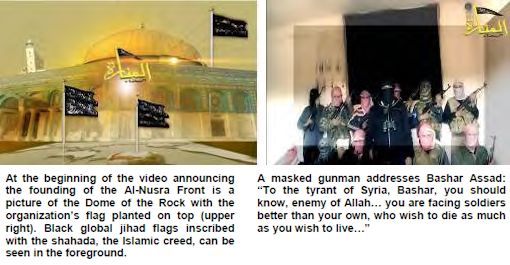
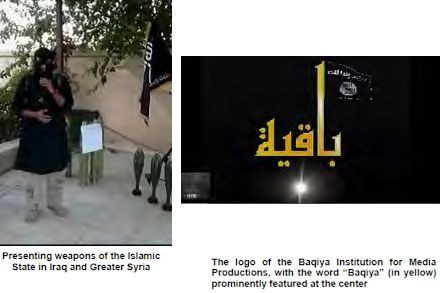
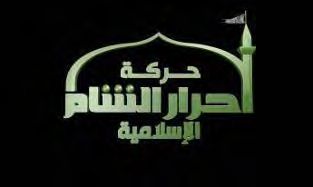

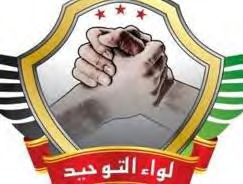
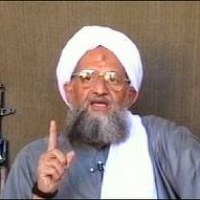
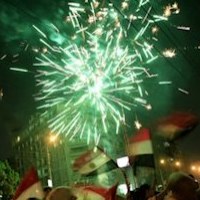







[…] Section One […]
[…] Section One […]